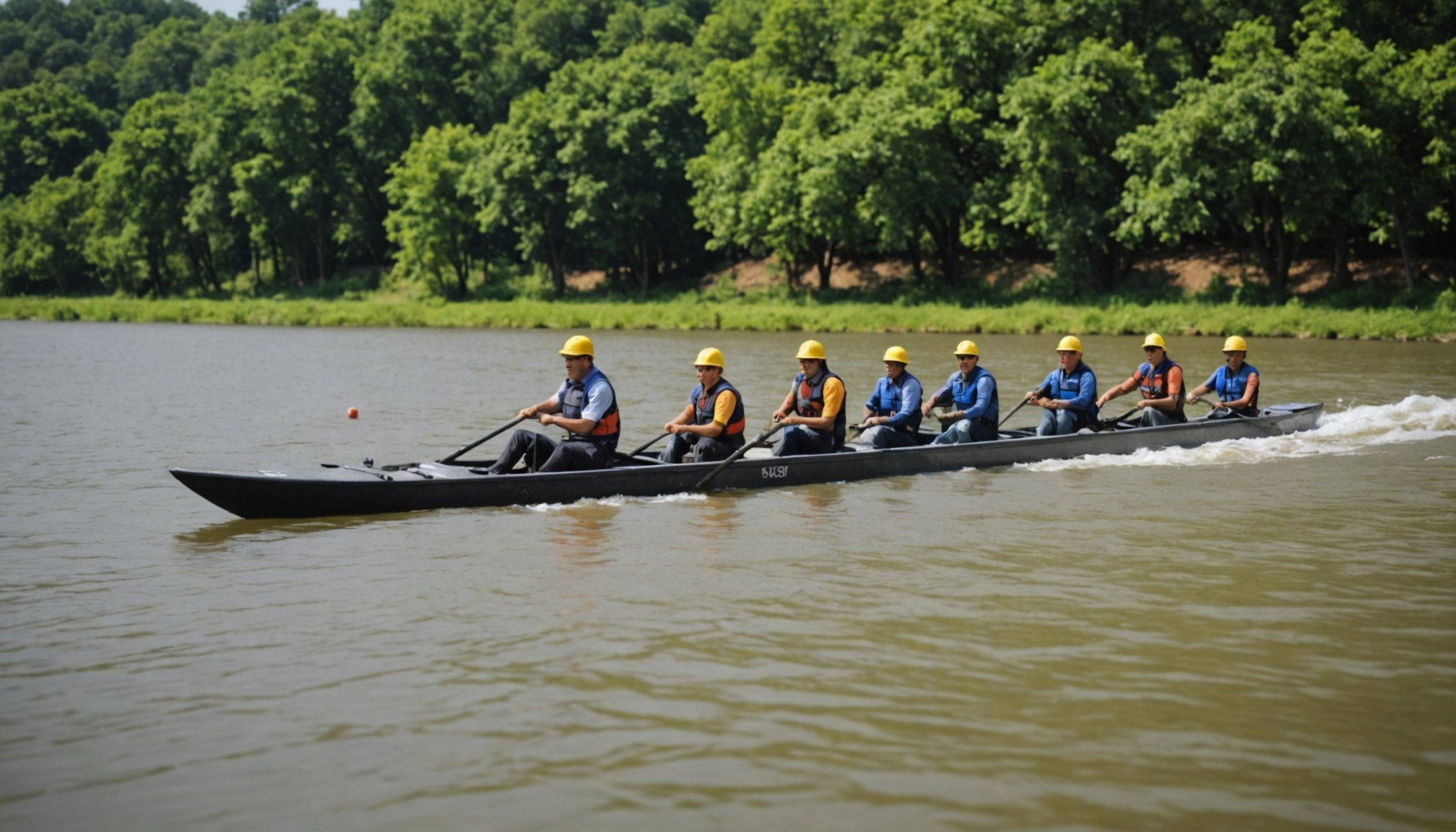Have you ever wondered how the efficiency of river logistics could be improved? Well, mastering fluvial gauging techniques is a game-changer in this field. Fluvial gauging, the process of measuring water flow in rivers, is crucial for optimizing logistics operations. In this article, we’ll dive deep into the techniques that can revolutionize how goods are transported via rivers, ensuring smoother and more efficient operations. Let’s explore how understanding and applying these methods can lead to significant improvements in logistics efficiency.
Fundamentals of fluvial gauging
Fluvial gauging is not just about sticking a stick in the water and calling it a day. It’s a sophisticated process that involves understanding the dynamics of water flow, sediment transport, and even the impact of weather patterns. Fluvial gauging helps logistics professionals predict water levels, which is essential for planning the movement of goods.
A lire aussi : Transformez vos événements grâce à une déco années folles en location
Key components of fluvial gauging
At the heart of fluvial gauging are several key components that logistics managers need to understand. First, there’s the velocity-area method, which involves measuring the velocity of water at different points across the river’s cross-section. Then, there’s the stage-discharge relationship, which correlates water levels with the volume of water flowing through the river. Finally, sediment transport plays a role, as it can affect the depth and navigability of rivers.
Importance of accurate data
Accurate data is the backbone of effective fluvial gauging. Without precise measurements, logistics planning becomes a guessing game. As Dr. Jane Rivers, a leading hydrologist, states, « Accurate fluvial data is not just a luxury; it’s a necessity for any logistics operation that relies on rivers. »
A lire aussi : Avis des salariés sur Homeserve : des retours majoritairement positifs
Techniques for mastering fluvial gauging
So, how can logistics professionals master fluvial gauging? It’s not just about understanding the theory; it’s about applying it effectively in the field. Let’s explore some techniques that can help you get a grip on this crucial aspect of river logistics.
Utilizing advanced technology
One of the most effective ways to master fluvial gauging is by leveraging advanced technology. Tools like Acoustic Doppler Current Profilers (ADCPs) and satellite imagery can provide real-time data on water flow and levels. For instance, an ADCP can measure water velocity at multiple depths, giving a comprehensive picture of the river’s flow dynamics.
Regular monitoring and data analysis
Regular monitoring is essential for staying on top of changing river conditions. By setting up a routine for data collection and analysis, logistics managers can anticipate changes in water levels and adjust their operations accordingly. John Smith, a logistics expert, notes, « Consistent monitoring allows us to be proactive rather than reactive, which is crucial for maintaining efficiency. »
Training and education
Another critical aspect of mastering fluvial gauging is ensuring that your team is well-trained. Workshops, seminars, and online courses can provide the necessary knowledge and skills. As Sarah Lee, a logistics trainer, emphasizes, « Educating your team on fluvial gauging techniques is an investment that pays off in improved operational efficiency. »
Impact of fluvial gauging on logistics efficiency
Now, let’s talk about the real impact of mastering fluvial gauging on logistics efficiency. You might be thinking, « How can a few measurements make such a big difference? » Well, the answer lies in the details.
Optimizing route planning
Accurate fluvial data allows logistics managers to plan routes more effectively. By knowing the water levels and flow rates, they can choose the most efficient paths for transporting goods. For example, if a river’s water level is low, a logistics manager might decide to use a different route or delay shipment until conditions improve.
Reducing delays and costs
One of the most significant benefits of mastering fluvial gauging is the reduction in delays and costs. When logistics operations are based on accurate data, there’s less room for error. This means fewer instances of ships getting stuck due to unexpected changes in water levels, which can save companies a lot of money. A study by The Logistics Institute found that companies that implemented advanced fluvial gauging techniques saw a 20% reduction in logistics costs.
Enhancing safety
Safety is another critical area where fluvial gauging makes a difference. By understanding the river’s dynamics, logistics managers can take steps to ensure the safety of their crews and cargo. For instance, if a river is prone to sudden changes in water levels, extra precautions can be taken to prevent accidents.
Challenges and solutions in fluvial gauging
Of course, mastering fluvial gauging isn’t without its challenges. Let’s explore some of the hurdles logistics professionals face and how they can overcome them.
Common challenges
One of the biggest challenges in fluvial gauging is the variability of river conditions. Rivers are dynamic systems, and their flow can change rapidly due to weather, seasonal changes, or human activities. Another challenge is the cost of advanced equipment, which can be prohibitive for some companies.
Solutions to overcome challenges
- Implementing cost-effective technologies: While advanced equipment can be expensive, there are more affordable options available. For instance, using drones equipped with sensors can provide valuable data at a lower cost.
- Collaborating with local authorities: Many local governments have access to fluvial data and can share it with logistics companies. Building partnerships with these authorities can help reduce the cost of data collection.
- Utilizing open-source data: There’s a wealth of open-source data available that can be used for fluvial gauging. By tapping into these resources, companies can gather valuable insights without breaking the bank.
- Investing in training: While it might seem counterintuitive, investing in training can actually save money in the long run. A well-trained team can use fluvial data more effectively, leading to better decision-making and cost savings.
- Adopting a proactive approach: By regularly monitoring river conditions and staying informed about weather patterns, logistics managers can anticipate changes and adjust their operations accordingly.
Case studies and real-world examples
To bring these concepts to life, let’s look at some real-world examples of how mastering fluvial gauging has improved logistics efficiency.
Case study: The Amazon River
The Amazon River, one of the world’s busiest waterways, is a prime example of how fluvial gauging can enhance logistics. Companies operating on the Amazon use advanced gauging techniques to navigate its complex network of tributaries. By understanding the river’s flow patterns, they can optimize their routes and reduce transit times. As Carlos Mendez, a logistics manager on the Amazon, explains, « Our ability to predict water levels has transformed our operations, allowing us to move goods more efficiently and safely. »
Case study: The Mississippi River
Another example is the Mississippi River, where logistics companies have implemented sophisticated fluvial gauging systems. These systems help them manage the river’s fluctuating water levels, which can vary dramatically due to seasonal changes and weather events. By using real-time data, companies can adjust their operations to avoid delays and ensure the safe passage of goods. Dr. Emily Waters, a hydrologist working on the Mississippi, notes, « The integration of fluvial gauging into logistics planning has been a game-changer, allowing us to navigate the river’s challenges more effectively. »
Future trends in fluvial gauging and logistics
Looking ahead, what does the future hold for fluvial gauging and its impact on logistics? Let’s explore some emerging trends and how they might shape the industry.
Integration of AI and machine learning
One of the most exciting trends is the integration of artificial intelligence (AI) and machine learning into fluvial gauging. These technologies can analyze vast amounts of data to predict water levels and flow patterns with unprecedented accuracy. For example, AI algorithms can process satellite imagery and historical data to forecast river conditions weeks in advance, allowing logistics managers to plan their operations more effectively.
Development of smart sensors
Another trend is the development of smart sensors that can be deployed in rivers to gather real-time data. These sensors can measure water levels, velocity, and even sediment concentration, providing a comprehensive picture of river conditions. By using smart sensors, logistics companies can monitor river dynamics in real-time, enabling them to make more informed decisions.
Collaboration and data sharing
Finally, there’s a growing trend towards collaboration and data sharing among logistics companies and government agencies. By pooling their resources and data, these organizations can gain a better understanding of river dynamics and improve their logistics operations. As Dr. Michael Stream, a logistics researcher, suggests, « The future of fluvial gauging lies in collaboration, where data sharing becomes the norm, leading to more efficient and sustainable logistics practices. »
Comparative analysis of fluvial gauging techniques
To help you understand the different fluvial gauging techniques and their applications, let’s compare three common methods:
| Technique | Description | Advantages | Disadvantages |
|---|---|---|---|
| Velocity-Area Method | Measures water velocity at different points across the river’s cross-section to calculate discharge. | – Provides detailed data on flow patterns – Can be used in various river conditions |
– Requires specialized equipment – Can be time-consuming |
| Stage-Discharge Relationship | Correlates water levels with the volume of water flowing through the river. | – Simple to implement – Useful for long-term monitoring |
– Less accurate for short-term changes – Requires historical data |
| Acoustic Doppler Current Profiler (ADCP) | Uses sound waves to measure water velocity at multiple depths. | – Provides real-time data – Highly accurate and versatile |
– Expensive equipment – Requires trained personnel |
In conclusion, mastering fluvial gauging techniques is essential for enhancing logistics efficiency. By understanding the fundamentals, applying advanced technologies, and staying informed about future trends, logistics professionals can navigate the challenges of river transport more effectively. Whether you’re operating on the Amazon, the Mississippi, or any other river, the insights and techniques discussed in this article can help you optimize your operations and achieve greater success.













